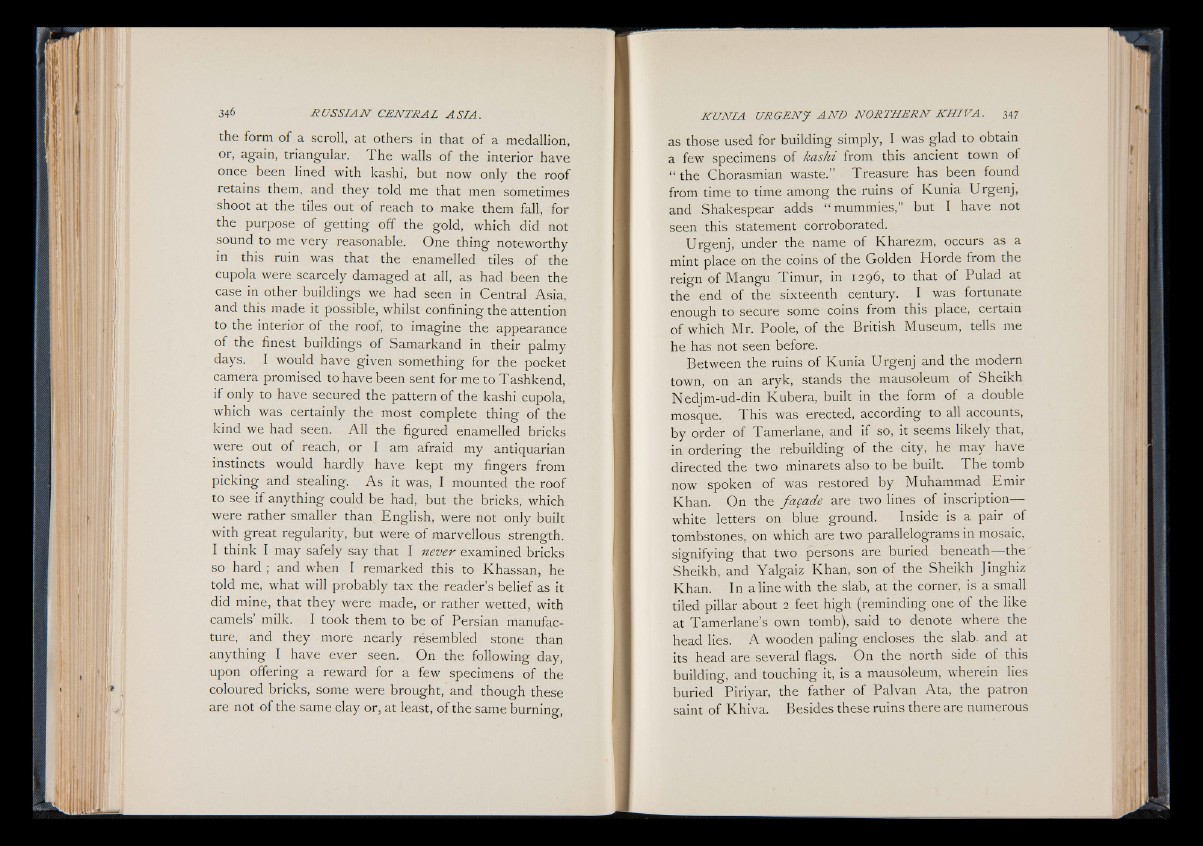
the form of a scroll, at others in that o f a medallion,
or, again, triangular. The walls o f the interior have
once been lined with kashi, but now only the roof
retains them, and they told me that men sometimes
shoot at the tiles out of reach to make them fall, for
the purpose of getting off the gold, which did not
sound to me very reasonable. One thing noteworthy
in this ruin was that the enamelled tiles o f the
cupola were scarcely damaged at all, as had been thè
case in other buildings we had seen in Central Asia,
and this made it possible, whilst confining the attention
to the interior of the roof, to imagine the appearance
of the finest buildings of Samarkand in their palmy
days. I would have given something for the pocket
camera promised to have been sent for me to Tashkend,
if only to have secured the pattern of the kashi cupola,
which was certainly the most complete thing of the
kind we had seen. All the figured enamelled bricks
were out of reach, or I am afraid my antiquarian
instincts would hardly have kept my fingers from
picking and stealing. A s it was, I mounted the roof
to see if anything could be had, but the bricks, which
were rather smaller than English, were not only built
with great regularity, but were of marvellous strength.
I think I may safely say that I never examined bricks
so hard ; and when I remarked this to Khassan, he
told me, what will probably tax the reader’s belief as it
did mine, that they were made, or rather wetted, with
camels’ milk. I took them to be of Persian manufacture,
and they more nearly resembled stone than
anything I have ever seen. On the following day,
upon offering a reward for a few specimens of the
coloured bricks, some were brought, and though these
are not of the same clay or, at least, of the same burning,
as those used for building simply, I was glad to obtain
a few specimens of kashi from this ancient town of
“ the Chorasmian waste.” Treasure has been found
from time to time among the ruins of Kunia Urgenj,
and Shakespear adds “ mummies,” but I have not
seen this statement corroborated.
Urgenj, under the name of Kharezm, occurs as a
mint place on the coins of the Golden Horde from the
reign of Mangu Timur, in 1296, to that of Pulad at
the end of the sixteenth century. I was fortunate
enough to secure some coins from this place, certain
of which Mr. Poole, of the British Museum, tells me
he has not seen before.
Between the ruins of Kunia Urgenj and the modern
town, on an aryk, stands the mausoleum of Sheikh
Nedjm-ud-din Kubera, built in the form of a double
mosque. This was erected, according to all accounts,
by order of Tamerlane, and if so, it seems likely that,
in ordering the rebuilding of the city, he may have
directed the two minarets also to be built. The tomb
now spoken of was restored by Muhammad Emir
Khan. On the façade are two lines of inscription—
white letters on blue ground. Inside is a pair of
tombstones, on which are two parallelograms in mosaic,
signifying that two persons are buried beneath— the
Sheikh, and Yalgaiz Khan, son of the Sheikh Jinghiz
Khan. In a line with the slab, at the corner, is a small
tiled pillar about 2 feet high (reminding one of the like
at Tamerlane’s own tomb), said to denote where the
head lies. A wooden paling encloses the slab, and at
its head are several flags. On the north side of this
building, and touching it, is a mausoleum, wherein lies
buried Piriyar, the father of Palvan Ata, the patron
saint of Khiva. Besides these ruins there are numerous